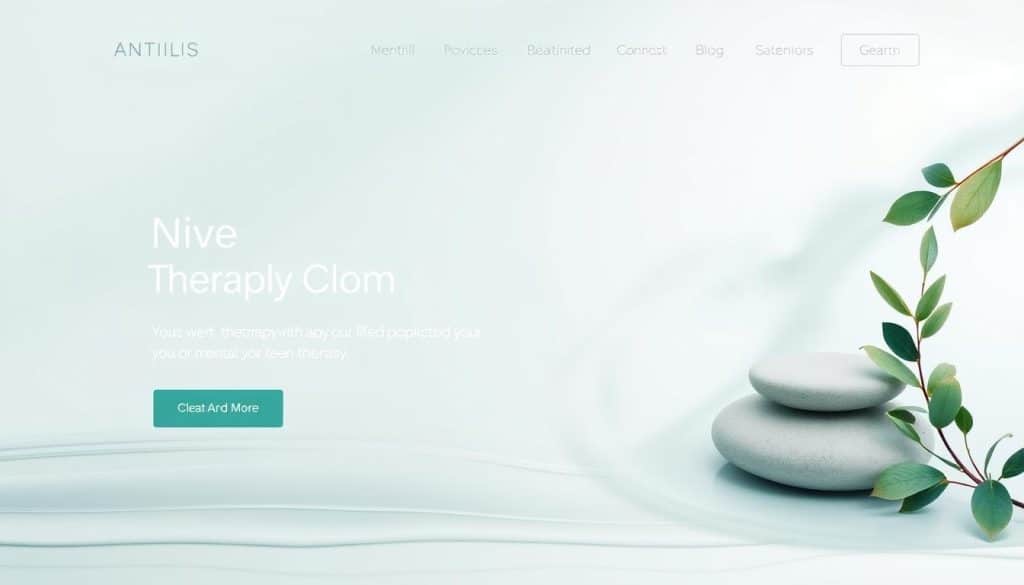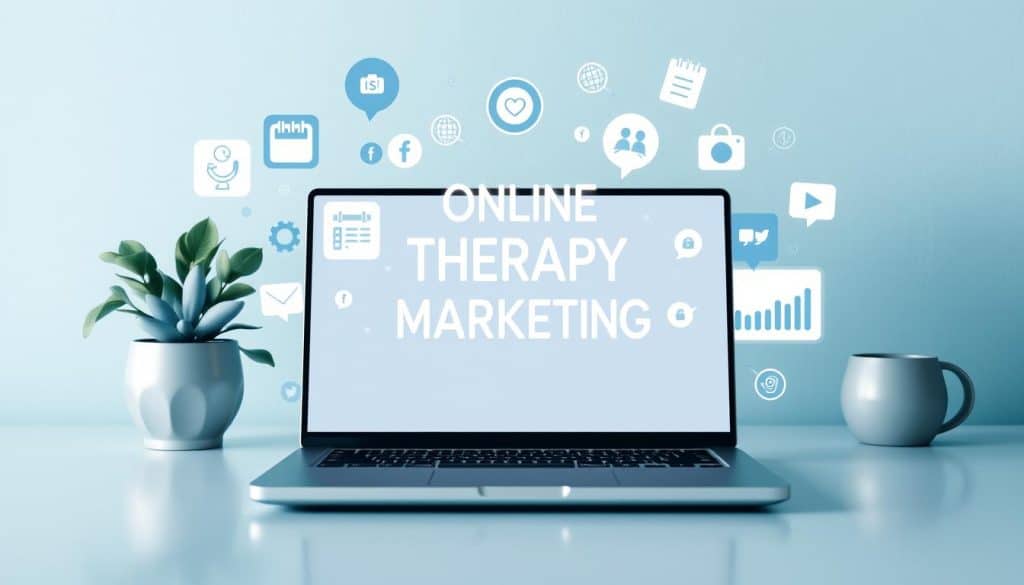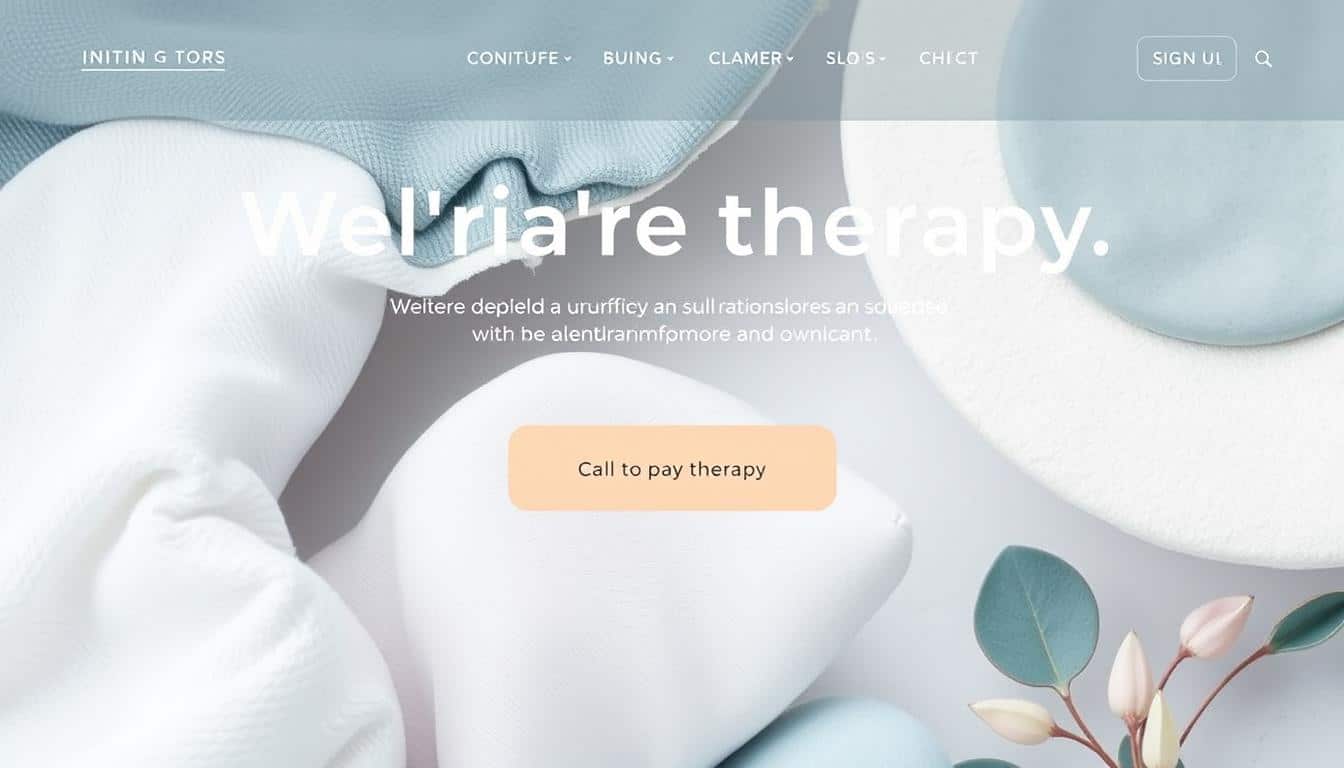Your therapy website is key in today’s digital world. It connects you with potential clients and shows off your skills. By using the right strategies, you can make your mental health practice stand out. This will improve how users experience your site and boost engagement and conversions.
Whether you’re an experienced therapist or new to online work, learning these key points is crucial. It helps you establish a strong online presence and grow your practice.
Key Takeaways
- Optimize your therapy website for user-friendly navigation and accessibility
- Leverage search engine optimization (SEO) strategies to improve visibility and attract the right clients
- Build trust and credibility through professional branding, client testimonials, and engaging content
- Implement effective marketing tactics, such as social media and local SEO, to promote your therapy services
- Ensure your website adheres to HIPAA compliance and data protection standards to protect client privacy
Creating a User-Friendly Therapy Website
Making a therapy website that speaks to your audience is key to drawing in clients. It’s important to focus on easy navigation and a clear site structure. Also, make sure your website works well on mobile devices and is easy for everyone to use.
Intuitive Navigation and Site Structure
Your website’s navigation should be simple and easy to follow. Organize your content in a way that makes sense, with clear labels. Use a big menu, breadcrumbs, and links to help visitors find what they need fast.
Also, design your site’s structure to make it easy for users to navigate. Put related content together, use clear page titles, and make sure your site is easy to use.
Mobile Responsiveness and Accessibility
Many people will visit your website on their phones. Make sure it looks good and works well on all devices. A clean design that changes size and shape as needed is important.
Also, make your website accessible to everyone. Add alt text for images, use easy-to-read fonts, and make sure it works with a keyboard. These steps help make your website welcoming to all users.
| Feature | Description | Importance |
|---|---|---|
| Intuitive Navigation | Clear and well-labeled menu, internal links, and breadcrumbs to help users find information easily. | High |
| Mobile Responsiveness | Adaptable design that provides a seamless user experience on mobile devices. | High |
| Accessibility | Inclusive features like alt text, clear typography, and keyboard navigation to accommodate users with disabilities. | High |
By focusing on a user-friendly website, you can improve how people use and enjoy your site. This helps you connect with more potential clients.
Optimizing for Search Engines
In today’s digital world, having a strong online presence is key for your therapy practice. To make your website easy to find, focus on keyword research and content optimization. These strategies are crucial for success.
Keyword Research and Content Optimization
Start with keyword research to find what people search for when looking for mental health services. This helps you create content that meets their needs. It’s a vital part of online therapy marketing strategies.
After finding the right keywords, optimize your website’s content. Use these keywords in your page titles, meta descriptions, headings, and body text. Also, make sure your content is informative and answers your clients’ questions. This is all part of therapy website SEO.
| Key Elements for Therapy Website SEO | Best Practices |
|---|---|
| Keyword Research |
|
| Content Optimization |
|
By using these online therapy marketing strategies, you can boost your therapy website SEO. This will help more people find your website. It’s a great way to grow your therapy practice.
“Effective mental health website optimization is the key to standing out in a crowded online landscape and connecting with the right clients.”
therapy website best practices
In today’s world, your therapy website is like a virtual door to your practice. It’s key to make it appealing and engaging. Focus on features that users love, SEO, and content that matters. This way, your website will attract, engage, and convert visitors.
Having intuitive navigation and site structure is crucial. Make your content easy to find and navigate. Use clear calls-to-action like “Schedule an Appointment” to guide visitors.
Also, your website must be mobile-responsive and accessible. With more people using mobiles, your site needs to work well on all devices. This improves user experience and search engine rankings.
Optimizing for Search Engines
To draw in the right people, your website needs to be search engine-friendly. Start with keyword research to find what people search for. Use these keywords in your content and site structure to boost your visibility.
Creating content that answers your audience’s questions is also key. This not only helps with SEO but also shows you’re an expert in therapy.
| Best Practices for Therapy Website Development | Benefits |
|---|---|
| Intuitive Navigation and Site Structure | Improved user experience and increased conversions |
| Mobile Responsiveness and Accessibility | Enhanced user experience and better search engine rankings |
| Keyword Research and Content Optimization | Increased visibility in search engine results and higher traffic |
By following these therapy website best practices, you’ll build a strong online presence. Your website is your practice’s digital face. Make sure it shows your expertise, values, and commitment to care.
Building Trust and Credibility
In today’s world, your therapy website is often the first thing people see. It’s key to show trust and credibility right away. Use professional branding, design, and client testimonials to build a strong connection with your audience.
Professional Branding and Design
Your website’s look is very important for therapy website usability and therapy website engagement. A good design shows you’re an expert and professional. Choose a clean layout, high-quality images, and colors that match your therapy style.
Client Testimonials and Reviews
Showing what happy clients say is a great way to boost mental health website conversion. Put client testimonials and reviews where everyone can see them. It builds trust and proves your services work.
“The personalized care and attention I received from this therapist made all the difference in my healing journey. I highly recommend their services.”
With a trustworthy and attractive website, you can draw in the right clients. This leads to more people seeking your therapy services.

Engaging Your Audience
Creating an engaging online presence is key for therapy website engagement and mental health website conversion. Use smart online therapy marketing strategies to grab your audience’s attention. This helps build a strong bond with potential clients.
Begin by making content that speaks to your audience. Post informative blogs, inspiring quotes, or fun quizzes on mental health topics. Ask visitors to share their thoughts and experiences. This creates a community around your practice.
- Post regular, quality content that teaches and motivates your audience.
- Use images, videos, and infographics to make your site more engaging.
- Encourage visitors to interact with your content through comments, surveys, or social media.
Also, add interactive features to your website to improve the user experience. Tools like mood trackers or goal-setting exercises make visitors feel more connected to their mental health.
“Engaging content and interactive features can transform your website into a valuable resource for your clients, building trust and fostering a meaningful connection.”
Keep in touch with your website visitors through email newsletters, social media, or personal messages. Share insights, mental health tips, and show off your expertise. This keeps your audience informed and interested.
| Engagement Strategies | Benefits |
|---|---|
| Compelling Content | Educates, inspires, and fosters a sense of community |
| Interactive Features | Enhances user experience and increases client investment |
| Ongoing Communication | Builds trust, showcases expertise, and keeps visitors engaged |
By focusing on therapy website engagement, mental health website conversion, and smart online therapy marketing strategies, you can build a lively and meaningful online space. This space will resonate with your audience and bring lasting success to your practice.
Promoting Your Therapy Services Online
As a therapist, using online marketing is key to reaching your audience. A strong online presence can help your practice grow. Here are some ways to promote your services online.
Social Media Marketing Strategies
Social media is a great way for therapists to connect with people. Create a professional page on Facebook, Instagram, and LinkedIn. Share your knowledge, post valuable content, and build a following.
Use social media to share educational resources, highlight your credentials, and engage with your audience. Ask clients to leave reviews and testimonials. This builds trust and credibility.
Local SEO and Directory Listings
For therapists, local SEO and directory listings are crucial. Make sure your website is optimized for local search with correct NAP information. Also, list your practice on reputable online directories like Google My Business, Yelp, and local business listings.
This makes it easier for people in your area to find you.
| Local SEO Tactics | Directory Listings |
|---|---|
|
|
By using these online therapy marketing strategies, you can improve your mental health website optimization and therapist website usability. This helps you reach more potential clients and grow your practice.

“A strong online presence is essential for therapists in today’s digital age. It can be the difference between a thriving practice and one that struggles to attract new clients.”
Ensuring Privacy and Security
In the world of online therapy, keeping your clients’ information safe is key. As a responsible website owner, following HIPAA rules and using strong data protection is vital. This helps build trust and keeps your clients safe.
HIPAA Compliance and Data Protection
Getting HIPAA compliant is crucial for protecting your website and your clients’ data. You need to use secure ways to talk, encrypt data, and control who can access it. Also, having clear privacy policies and getting your clients’ consent is important.
To keep your online counseling site safe, follow these tips:
- Use encrypted video chats and messages to keep talks private.
- Set up strong passwords, two-factor authentication, and roles to control access.
- Update your privacy policies often to meet new data protection laws.
- Be open with your clients about how their data is used and stored.
- Train your team on HIPAA and data security to keep information safe.
By focusing on privacy and security, you build trust with your clients. This can lead to better therapy results and a stronger reputation in the mental health field.
“Protecting client privacy is not just a legal requirement, it’s a moral obligation that lies at the heart of ethical therapy practice.”
Measuring and Improving Performance
It’s key to track your therapy website’s performance to ensure it meets your clients’ needs. By analyzing important metrics like website engagement and conversion rates, you can spot areas for betterment. This helps you make informed decisions to improve your online space.
Use tools like Google Analytics to understand your website’s traffic and user behavior. Look at page views, bounce rates, and time on site to see how visitors interact with your content. This info helps you improve your messaging and user experience, making your website more effective.
Also, ask for feedback from your clients through surveys or reviews. Their opinions can give you insights on what’s good and what needs work. By always measuring and improving your website, you can strengthen your online presence and build closer connections with your clients.



